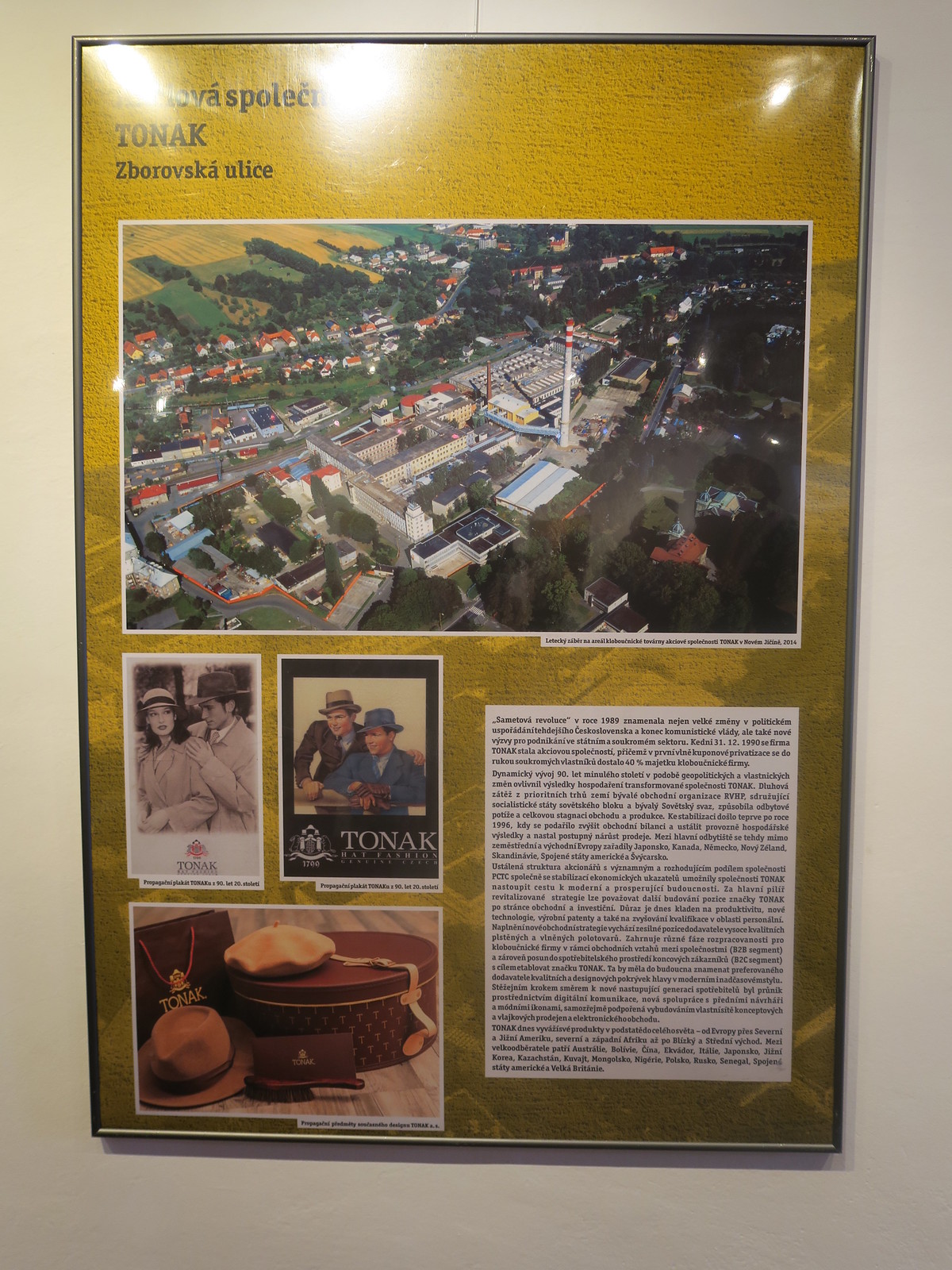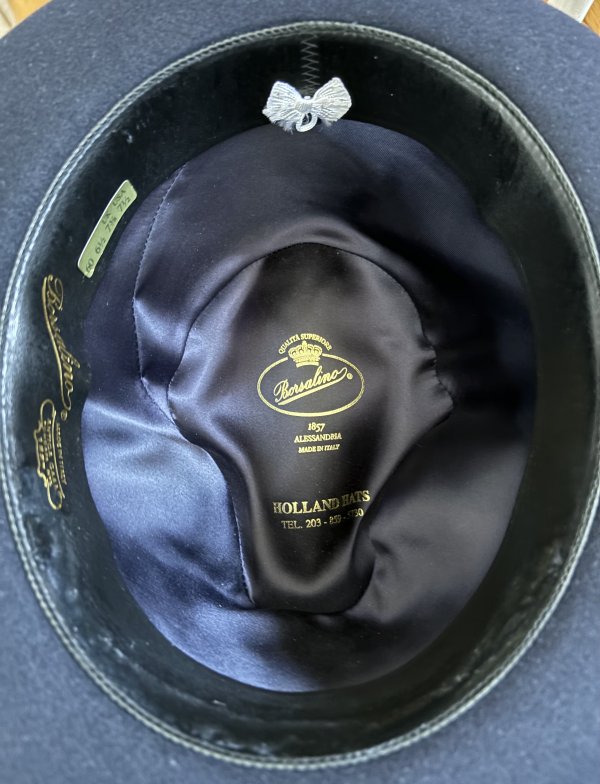- Messages
- 17,698
- Location
- Maryland
TONAK - Formerly Hückel "Zephyr" "Seal Velour" possibly later 1940s and shortly after J. Hückel´s Söhne / JHS was nationalized as TONAK. The "Zephyr" "Seal Velour" is still approaches the high level of JHS and was made for the American market. I found this Velour back in 2013.






NOVÝ JIČÍN - Town of Chimneys, September 7 - 29, 2019, Radek Polách, Realization: Municipal Cultural Center Nový Jičín, contributory organization Museum of Nový Jičín, contributory organization State District Archive Nový Jičín.
This is the Tonak part of the exposition.
Tonak 1945 - 1989

The end of the Second World War brought not only a new composition of the management of the hat factory in Nový Jičiná, but also new intentions connected with the renewed Czechoslovak Republic. The October decree of the President of the Czechoslovak Republic, Edvard Beneš, meant the merger of three Nový Jičín hatter companies into one, including the Janyška factory in Walachia. On May 27, 1946, the National Administration of the Johann Hückel's Sóhne factory, a hat factory, requested that the company be deleted from the Commercial Register of the Regional Court in Nový Jičín. The change was to be made in connection with the presidential decree with the assets to the company: Hat factories, national enterprise. As of June 4, 1946, the erasure was carried out by Johann Hfickens Schhnetak officially ceased to exist. After the takeover of power in Czechoslovakia in February 1948 by the Communist Party headed by Klement Gottwald, the hatter's factories were linked to a dozen smaller factories in Bohemia and Moravia under the Act on Further Nationalization. Thus, a total of 24 plants were incorporated into the TONAK company. In 1949, the national hat production company Otavan, based in Katowice, was established. All factories in the Czech Republic were assigned to him from the national company TONAK. The race in Nový Jičín was named TONAK 1, the race in Valašské Meziria TONAK 2 and the Prague race was named TONAK 3. In NovýJičín, the individual races were also numbered. By these changes, the TONAK factory in Nový Jičín became the main pillar of the production of felt hats throughout Czechoslovakia. The national company TONAK has taken care of the training of new employees from the very beginning. After the war and the expulsion of the German population, there were very few specialists left in Nový Jičín and the management had to use the professional capacities of the former Czech factory Janyška in Valašské Menne. workers. In 1963, it grew into a corporate technical school of hat-making technology, which was led by the then-skilled employees of the hat factory.
Significant changes occurred in 1967. At that time, the reconstruction of the entire hat shop in Nový Jičín began. In the course of this, the factory was looked at by the Minister of Industry and Trade Božena Machačová-Dostálová, who supported further development of hat production. In 1969 the hat factory in Nový Jičín processed 19 million animal skins a year, with only one million being imported. Almost 74,510 production at that time was intended for export to know more than fifty countries around the world. During the normalization period, TONAK has been relatively stable during the normalization period. when production and employment made the hat factory one of the most important economic elements of the whole Nový Jičín region. However, this era brought with it a number of other factors, which meant particularly paralyzing direct contacts with the new fashion guilty of Western European countries. The main component of sales were still mass-produced hat products for the countries of the socialist sector. Further changes occurred after 1989.
Tonak 1989 - Present

The “Velvet Revolution” in 1989 meant not only major changes in the political organization of Czechoslovakia and the end of the communist government, but also new challenges for doing business in the public and private sectors. On December 31, 1990, TONAK «became a joint-stock company, with 40% of the hatter's property being the first to blame for coupon privatization. The dynamic development of the 1990s in the form of geopolitical and ownership changes influenced the economic results of the transformed TONAK company. Debt burden from the priority markets of the country of the former trade organization RVHP, associating socialist states of the Soviet bloc and the former Soviet Union, caused sales difficulties and overall stagnation of trade and production. Stabilization occurred only after 1996, when the balance of trade was increased and the operating results stabilized and a gradual increase in sales occurred. Japan, Canada, Germany, New Zealand, Scandinavia, the United States of America and Switzerland ranked among the main markets at that time outside of Central and Eastern Europe. The steady-state shareholder structure with Pat's significant and decisive shareholding, together with the stabilization of economic indicators, enabled TONAK to take the path to a modern and prosperous future. As the main pillar of the revitalized strategy we can consider further building the position of the TONAK brand in terms of business and investment. Today, the focus is on productivity, new technologies, manufacturing patents and on increasing personnel qualifications. Stressful trade strategy is based on strong positioning of high quality felt and quality semi-finished products. It includes various phases of development for hat companies in the business relations between companies (B2B segment) and at the same time into the consumer environment of the end customers (B2C segment) with the goal of creating the brand TONAK. In the future, it should be the preferred supplier of quality and design of new headgear in modern in-time style. A key step towards a new emerging generation of consumers was the breakthrough through digital communication, new collaboration with leading designers and fashion icons, of course backed by the building of own network of flagship and flagship stores and e-commerce. TONAK today, we export almost all over the world - from Europe to North and South America, North and West Africa to the Near and Middle East. Wholesale customers include Australia, Bolivia, China, Ecuador, Italy, Japan, South Korea, Kazakhstan, Kuwait. Mongolia, Nigeria, Poland, Russia, Senegal. United States and United Kingdom.
The entire exposition is available here ( Brüder Böhm Neutitschein, Anton Peshel Neutitschein, J. Hückel´s Söhne, Tonak).

 germanaustrianhats.invisionzone.com
germanaustrianhats.invisionzone.com






NOVÝ JIČÍN - Town of Chimneys, September 7 - 29, 2019, Radek Polách, Realization: Municipal Cultural Center Nový Jičín, contributory organization Museum of Nový Jičín, contributory organization State District Archive Nový Jičín.
This is the Tonak part of the exposition.
Tonak 1945 - 1989

The end of the Second World War brought not only a new composition of the management of the hat factory in Nový Jičiná, but also new intentions connected with the renewed Czechoslovak Republic. The October decree of the President of the Czechoslovak Republic, Edvard Beneš, meant the merger of three Nový Jičín hatter companies into one, including the Janyška factory in Walachia. On May 27, 1946, the National Administration of the Johann Hückel's Sóhne factory, a hat factory, requested that the company be deleted from the Commercial Register of the Regional Court in Nový Jičín. The change was to be made in connection with the presidential decree with the assets to the company: Hat factories, national enterprise. As of June 4, 1946, the erasure was carried out by Johann Hfickens Schhnetak officially ceased to exist. After the takeover of power in Czechoslovakia in February 1948 by the Communist Party headed by Klement Gottwald, the hatter's factories were linked to a dozen smaller factories in Bohemia and Moravia under the Act on Further Nationalization. Thus, a total of 24 plants were incorporated into the TONAK company. In 1949, the national hat production company Otavan, based in Katowice, was established. All factories in the Czech Republic were assigned to him from the national company TONAK. The race in Nový Jičín was named TONAK 1, the race in Valašské Meziria TONAK 2 and the Prague race was named TONAK 3. In NovýJičín, the individual races were also numbered. By these changes, the TONAK factory in Nový Jičín became the main pillar of the production of felt hats throughout Czechoslovakia. The national company TONAK has taken care of the training of new employees from the very beginning. After the war and the expulsion of the German population, there were very few specialists left in Nový Jičín and the management had to use the professional capacities of the former Czech factory Janyška in Valašské Menne. workers. In 1963, it grew into a corporate technical school of hat-making technology, which was led by the then-skilled employees of the hat factory.
Significant changes occurred in 1967. At that time, the reconstruction of the entire hat shop in Nový Jičín began. In the course of this, the factory was looked at by the Minister of Industry and Trade Božena Machačová-Dostálová, who supported further development of hat production. In 1969 the hat factory in Nový Jičín processed 19 million animal skins a year, with only one million being imported. Almost 74,510 production at that time was intended for export to know more than fifty countries around the world. During the normalization period, TONAK has been relatively stable during the normalization period. when production and employment made the hat factory one of the most important economic elements of the whole Nový Jičín region. However, this era brought with it a number of other factors, which meant particularly paralyzing direct contacts with the new fashion guilty of Western European countries. The main component of sales were still mass-produced hat products for the countries of the socialist sector. Further changes occurred after 1989.
Tonak 1989 - Present

The “Velvet Revolution” in 1989 meant not only major changes in the political organization of Czechoslovakia and the end of the communist government, but also new challenges for doing business in the public and private sectors. On December 31, 1990, TONAK «became a joint-stock company, with 40% of the hatter's property being the first to blame for coupon privatization. The dynamic development of the 1990s in the form of geopolitical and ownership changes influenced the economic results of the transformed TONAK company. Debt burden from the priority markets of the country of the former trade organization RVHP, associating socialist states of the Soviet bloc and the former Soviet Union, caused sales difficulties and overall stagnation of trade and production. Stabilization occurred only after 1996, when the balance of trade was increased and the operating results stabilized and a gradual increase in sales occurred. Japan, Canada, Germany, New Zealand, Scandinavia, the United States of America and Switzerland ranked among the main markets at that time outside of Central and Eastern Europe. The steady-state shareholder structure with Pat's significant and decisive shareholding, together with the stabilization of economic indicators, enabled TONAK to take the path to a modern and prosperous future. As the main pillar of the revitalized strategy we can consider further building the position of the TONAK brand in terms of business and investment. Today, the focus is on productivity, new technologies, manufacturing patents and on increasing personnel qualifications. Stressful trade strategy is based on strong positioning of high quality felt and quality semi-finished products. It includes various phases of development for hat companies in the business relations between companies (B2B segment) and at the same time into the consumer environment of the end customers (B2C segment) with the goal of creating the brand TONAK. In the future, it should be the preferred supplier of quality and design of new headgear in modern in-time style. A key step towards a new emerging generation of consumers was the breakthrough through digital communication, new collaboration with leading designers and fashion icons, of course backed by the building of own network of flagship and flagship stores and e-commerce. TONAK today, we export almost all over the world - from Europe to North and South America, North and West Africa to the Near and Middle East. Wholesale customers include Australia, Bolivia, China, Ecuador, Italy, Japan, South Korea, Kazakhstan, Kuwait. Mongolia, Nigeria, Poland, Russia, Senegal. United States and United Kingdom.
The entire exposition is available here ( Brüder Böhm Neutitschein, Anton Peshel Neutitschein, J. Hückel´s Söhne, Tonak).

NOVÝ JIČÍN - Town of Chimneys, September 7 - 29, 2019
This is the opening of the exhibition "NOVÝ JIČÍN - Town of Chimneys". There was a lot of interesting information on the hat companies. Also an early 1940s film from JHS that I will try to get a copy of the video. NOVÝ JIČÍN - Town of Chimneys, September 7 - 29, 2019, Radek Polách Realization: Mu...






